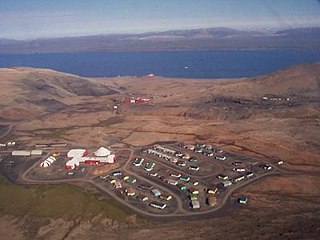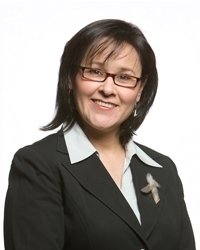
Iqaluit is the capital of the Canadian territory of Nunavut, its largest community, and its only city. It was known as Frobisher Bay from 1942 to 1987, after the large bay on the coast on which the city is situated. The northernmost city in Canada, its traditional Inuktitut name was restored in 1987.
The Canadian Foundation for Climate and Atmospheric Sciences (CFCAS) was Canada's main funding body for university-based research on climate, atmospheric, and related oceanic work. It is now the Canadian Climate Forum. As an autonomous, charitable foundation established in 2000, CFCAS funded research that improved the scientific understanding of processes and predictions, provided relevant science to policy makers, and improved understanding of the ways in which these challenges affect human health and the natural environment in addition to strengthening Canada's scientific capacity. Its chair is Gordon McBean.

Rankin Inlet is an Inuit hamlet on the Kudlulik Peninsula in Nunavut, Canada. It is the largest hamlet and second-largest settlement in Nunavut, after the territorial capital, Iqaluit. On the northwestern Hudson Bay, between Chesterfield Inlet and Arviat, it is the regional centre for the Kivalliq Region.

Alert, in the Qikiqtaaluk Region of Nunavut, Canada, is the northernmost continuously inhabited place in the world, on Ellesmere Island at latitude 82°30'05" north, 817 kilometres (508 mi) from the North Pole. It takes its name from HMS Alert, which wintered 10 km (6.2 mi) east of the present station, off what is now Cape Sheridan, in 1875–1876.

Eureka is a small research base on Fosheim Peninsula, Ellesmere Island, Qikiqtaaluk Region, in the Canadian territory of Nunavut. It is located on the north side of Slidre Fiord, which enters Eureka Sound farther west. It is the third-northernmost permanent research community in the world. The only two farther north are Alert, which is also on Ellesmere Island, and Nord, in Greenland. Eureka has the lowest average annual temperature and the lowest amount of precipitation of any weather station in Canada.

Resolute or Resolute Bay is an Inuit hamlet on Cornwallis Island in Nunavut, Canada. It is situated at the northern end of Resolute Bay and the Northwest Passage and is part of the Qikiqtaaluk Region.

There are an estimated 850 km (530 mi) of roads and highways across the Canadian territory of Nunavut, which is the only province/territory not connected by road to other parts of Canada.

Clyde River is an Inuit hamlet located on the shore of Baffin Island's Patricia Bay, off Kangiqtugaapik, an arm of Davis Strait in the Qikiqtaaluk Region, of Nunavut, Canada. It lies in the Baffin Mountains which in turn form part of the Arctic Cordillera mountain range. The community is served by air and by annual supply sealift.

Nanisivik is a now-abandoned company town which was built in 1975 to support the lead-zinc mining and mineral processing operations for the Nanisivik Mine, in production between 1976 and 2002. The townsite is located just inland from Strathcona Sound, about 20 km (12 mi) east of the community of Arctic Bay in the Canadian territory of Nunavut.

Leona Aglukkaq is a Canadian politician. She was a member of the non-partisan Legislative Assembly of Nunavut representing the riding of Nattilik from 2004 until stepping down in 2008; then was a Conservative Member of Parliament representing the riding of Nunavut after winning the seat in the 2008 federal election. She was the first Conservative to win the seat, and only the second centre-right candidate ever to win it. Leona Aglukkaq is the first Inuk woman to serve in cabinet. She remained an MP until she was defeated in the 2015 federal election by Liberal candidate Hunter Tootoo. Aglukkaq unsuccessfully contested the 2019 federal election.
Levinia Nuqaalaq Brown is a Canadian politician who served as the Member of the Legislative Assembly (MLA) for the electoral district of Rankin Inlet South/Whale Cove in the Legislative Assembly of Nunavut from 2004 to 2008. She was elected as a MLA on February 16, 2004, and further elected by other MLAs to serve on the Executive Council of Nunavut. Premier Paul Okalik named her as the Deputy Premier on March 9, 2004. She also served as the territory's Minister of Community and Government Services.

Ennadai Lake is a lake in the Kivalliq Region, Nunavut, Canada. It is 84 km (52 mi) long, and 4.8 to 22.5 km wide. It is drained to the north by the Kazan River. A 615 km (382 mi) section of the Kazan River from the outlet of Ennadai Lake to Baker Lake, was designated as a part of the Canadian Heritage Rivers System in 1990.

Nunavut is the largest and northernmost territory of Canada. It was separated officially from the Northwest Territories on April 1, 1999, via the Nunavut Act and the Nunavut Land Claims Agreement Act, which provided this territory to the Inuit for independent government. The boundaries had been drawn in 1993. The creation of Nunavut resulted in the first major change to Canada's political map in half a century since the province of Newfoundland was admitted in 1949.
The Mary River Mine is an open pit iron ore mine on Inuit Owned Land (IOL) operated by the Baffinland Iron Mines Corporation (BIMC), in the Mary River area of the Qikiqtaaluk Region, on Baffin Island, Nunavut, in the Canadian Arctic Archipelago. As of 2021, Mary River mine operation consists of an open-pit mine, two work camps for hundreds of workers, a tote road—from the Mary River site to Milne Inlet—and a port infrastructure at Milne Inlet. According to a 4-year study published in 2008, the Mary River Mine, with its four massive iron ore deposits of 65-70% pure iron ore was "one of the most promising undeveloped iron deposits on the planet". It was not until technological advances were in place in 2010, and the market for iron ore had dramatically increased that sizable financial backing for the high cost of development in a remote region known for its inhospitable climate, was available. The mine began operations in 2014, and the first shipment to Europe arrived in 2015. Baffinland is currently planning on expanding the mine. In February 2021, a group of Inuit hunters blockaded access to the mine for a week to protest the expansion.
Polaris zinc mine was a former underground mine on Little Cornwallis Island in the Canadian territory of Nunavut. The Polaris zinc mine was located 1,120 km (700 mi) north of the Arctic Circle, and 96 km (60 mi) north of the community of Resolute. The Polaris mine closed in July 2002 following more than twenty years of zinc production.

The Nanisivik Naval Facility is a Canadian Forces naval facility on Baffin Island, Nunavut. The station is built at the former lead-zinc mine site near the former company town of Nanisivik. The facility was undergoing final testing in mid-2019. Full operational capability had been expected to be achieved by mid-2020 with the first refuelling of a Royal Canadian Navy ship. However, in July 2020 it was confirmed that work on the facility would not be completed until 2022. On 30 March 2022, it was reported that the completion of the facility would be further delayed to 2023. Then in November 2022, the Auditor General of Canada reported that the facility would start to be used by the navy regularly beginning in 2025.
The Canadian federal budget for fiscal year 2012–13 was presented to the House of Commons of Canada by Finance Minister Jim Flaherty on 29 March 2012. Among the most notable elements of the federal budget were changes to Old Age Security and a reduction of the budget for the Canadian Forces and the Canadian Broadcasting Corporation.
Mumilaaq Qaqqaq is a Canadian activist and former politician who served as the Member of Parliament (MP) for Nunavut in the House of Commons of Canada from 2019 to 2021.

The COVID-19 pandemic in Nunavut is an ongoing viral pandemic of coronavirus disease 2019 (COVID-19), a novel infectious disease caused by severe acute respiratory syndrome coronavirus 2 (SARS-CoV-2).
Enooyaq Sudlovenick is an Inuk Canadian marine biologist. She was a recipient of the 2021 Weston Family Awards in Northern Research for her research into the health of marine animals of the Arctic.













